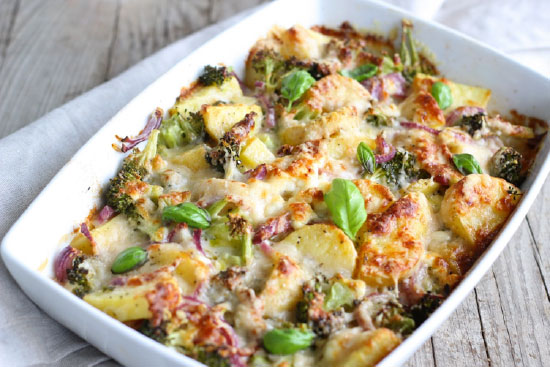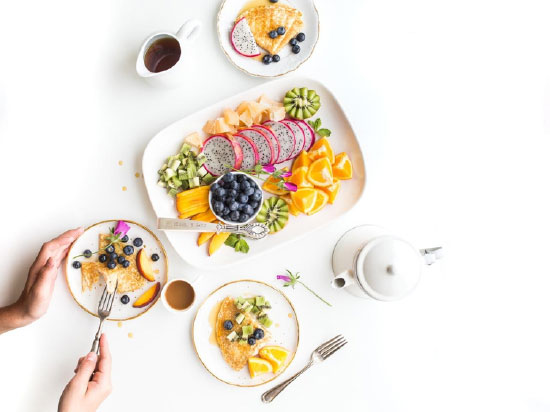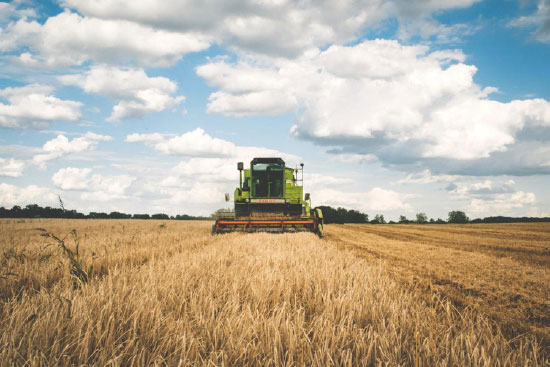The term “clean eating” is one of the latest top trends for keeping your body healthy. But what does it really mean?
Clean eating, you’d think, would be pretty self-explanatory. But there are nuances to the movement that might not be clear. Thus this post!
The idea behind “clean eating” is the food you put in your body should be as untouched by chemicals and additives as possible. Processed foods are out. Completely. High sugar content is also out, although arguably fruits have a high sugar content, but the point of clean eating is that what goes into your body, goes in there as it was when it left the ground…and that the ground it left was untouched by harmful chemicals, pesticides and various other nasties.
A very simple example of a clean eating breakfast would be a cup of filtered water with a slice of organic lemon followed by a free range fresh egg on a bed of organic spinach.
Some take this to the extreme and try to eat only foods they have grown or raised themselves. This is a fabulous idea if you have the time, or space, to tend to a vegetable garden and you aren’t squeamish when it comes to hunting, plucking and gutting your own animals. (Not my cup of tea, although I have prepared fresh seafood someone I knew had caught and gutted himself.)
Modern Life’s Affects on Clean Eating
Our diets have suffered a lot since we became busier. The traditional family set up of the old days, where the wife would stay at home baking bread and care for the children — a traditional homemaker — while the husband went out to provide the family with a roof over their head and manage the finances, has changed dramatically. Most couples now feel so much financial pressure they both have to work. In addition, there are more single-parent families than ever before and less and less time is available to focus on the routine of dinner time, sitting down together and enjoying a home cooked meal. Convenience is the buzzword of the 21st century and with it the rise of highly processed convenience foods. However, that convenience does come with a rather detrimental effect on our health.
Creating foods that stand up to the demands of the modern family means a higher turnover of crops, cheaper commercial value to offer better retail value, the addition of preservatives to ensure products last longer and, of course, the basic human need for food to look a particular way. For example, when I was in high school, I job shadowed a marine biologist. One of our stops that day was at a lobster aquaculture facility. They had to add specific things to the lobsters’ diet in order for them to turn the color we’ve all grown accustomed to. The lobsters didn’t need that item for nutrition … it was all for color’s sake. There is a lot to the psychology of the color of food, but I won’t go into that here.
Another example: Major supermarkets refuse to stock apples of a certain shape due to customer wastage. John doesn’t want to buy the smaller oddly shaped apple when it is surrounded by the visual masterpiece of all the other perfectly round and shiny apples. That’s ok John. It isn’t just you, we are all a little guilty of wanting the brightest pick of the crop.
It is important to remember the bi-product of this demand is actually poorer quality goods. Farmers are using more technology to ensure they can get a higher yield of perfectly formed produce. Our vegetables are plastered with pesticides because the consumer doesn’t want to share their dinner plate with a friendly worm or a zucchini that looks like it’s been given to you second hand by a family of snails. The green fingered amongst us don’t mind a sharing their lunch with a few of nature’s critters, although there are ways of keeping off the larger pests who steal our modest crop of carefully nurtured greens — naturally. The impact of these demands on our health can lead to some rather scary illnesses including cancer, allergies and others.
Then there is livestock. The way we treat animals bred for food is by far a lot more humane than many countries, but as the consumer demands better quality product for better value price tag, they appear to turn a blind eye to scary words such as ‘genetically modified’ or simply forget that higher demand for lower commercial value, means pile them high and move them on. So chickens, cows and sheep are bred in cramped conditions with less freedom than nature intended. I remember when I wrote for the Maryland Agricultural Experiment Station, I did a story on pig farming. Some of the things done to pigs to make sure they had plenty of piglets, grew larger and fattier, etc. horrified me.
The other issue with convenience foods is the potential for harmful bacteria to spread and the likelihood of listeria and E. coli to develop, spilling over into our homes and lives. This increases the importance of understanding the dangers of food processing and researching solutions. A great site to gain some information can be found here www.unsafefoods.com/category/listeria/ if you want a more in-depth look into unsafe foods and how to avoid them.
How to Incorporate Clean Eating Into Your Life
Clean eating is the first line of defense in protecting yourself from illness and from chemicals you don’t understand (nor need in your system). It isn’t as inconvenient as one might presume. However, it does involve a degree of organization, perhaps a little more money spent on groceries and a desire to make a difference in your future and the safety of your children’s health.

Image from Gratisography
Here are some steps you can take to eat more “cleanly” and healthfully:
First, be more aware of what you are purchasing. Start looking at the packaging and get to know what all those symbols and claims really mean. The less distance your food has had to travel, the better it is.
Shop at farmers markets for local produce. They are sometimes even less expensive than what you find at the grocery store.
When you can, choose organic foods. If you have a farm shop near you then this is your playground. When it comes to meat, consider the welfare of the animal and go for produce coming from smaller, local farms.
Juicing is a fantastic way of clean eating and packing your family full of great vitamins. I wrote a piece on Juices earlier in the blog.
Buy fresh and if you want simple, ready to go meals, take a day to prepare and cook. For some of us the idea of spending a day in the kitchen is a dream, for others, it is more than a chore. However, the overall impact on your health and wellbeing far outweighs the little effort it takes to be prepared. You can even pack your big day of cooking into serving ready packages. Nowawdays, there are plenty of options for creating your own TV dinners.
Chicken, if prepared correctly, can be roasted, removed from the bone and stored in the fridge for up to 3 days. If you are freezing it, then it will last a few months. Ensure you defrost it thoroughly and consume it within 24 hours of it being defrosted, though.
Most meat can be kept for a similar time once cooked and frozen in the same manner. Always ensure food is cooled before putting it into cold storage. Placing hot food into a cold fridge will increase the temperature and this allows germs to multiply and breed which can then put you at risk of contamination.

Image supplied by Pixabay
Organize Your Frig for Clean Eating
Keeping your fridge organized is also important and you can do this by sticking to this guide on how to store food safely
Top and Middle Shelf. – ready to eat foods.
Starting on the top shelf, it is best to kick things off with your dairy products. Cheese, yogurt and cream. Moving down to the middle shelf we find cooked meats and prepared salads. All ready-to-eat foods should be packaged and sealed, especially cooked meats. Storing these foods at the top of the fridge prevents them becoming contaminated by your raw meats.
Bottom Shelf – raw meats.
Fish, poultry and other raw meat should all be kept at the bottom of the fridge where they cannot drip or touch other foods. Keep each individual item wrapped and sealed. It may also be useful to store this on a tray which can be removed and cleaned to help reduce raw meat contaminating the shelf above your salad drawer.
Salad Drawers – vegetables, herbs and washed salad.
While the location of the salad drawer isn’t ideal, it is the best way of making the space in a domestic fridge work. Make sure all vegetables and salads are washed before storing and ideally wrapped, either in their packaging or in brown paper bags, protecting them from any contamination while allowing them to breath
Passing Clean Eating on to the Next Generation
There are plenty of recipes you can create using fresh ingredients that take less than 20 minutes to prepare. Stir fries are a fantastic way of getting food out quickly. Fresh fish can be grilled in under 15 minutes and served with steamed vegetables for a really healthy and delicious alternative to a ready meal.
Taking the time to prepare and organize your weekly dinners on the weekend will give you the freedom to cook quickly without reaching for the bad-for-you alternatives. It can help to create a meal planner so you know ahead of time what you are going to be eating and, also, get your children involved with the preparing. Even young children can help mix up eggs or collect different vegetables from the store.
In fact, use clean eating as a way to educate your children about diet and nutrition. Give them a great relationship with the foods they put in their bodies at a young age so they are more apt to maintain a healthy diet as they grow up. Raw carrots are often loved more than cooked carrots, but they aren’t the only vegetable that can be eaten raw. Broccoli, cauliflower and green beans can all be nibbled on by children while you share the importance of nutrition with them.
Take time to consider your future and the lessons you want to teach your children. There is a saying, “You are what you eat” — so think about that the next time you load your freezer up with cheap, popular ready-made meals.

Take Charge of Your Health!
Changing your eating habits can be tough. But it doesn’t have to be if you take a little time to think it out and create a plan.
This Healthy Eating Worksheet will walk you through the process of creating a healthy eating plan. All you need to do is print it out, set aside some time to complete it, and then fill it out. Then you can create your plan, knowing that you have addressed potential obstacles and came up with some creative ways to handle them.




